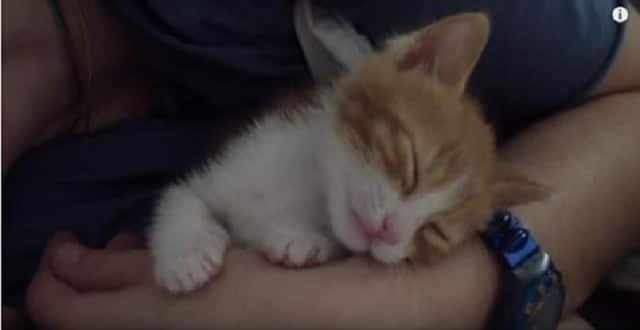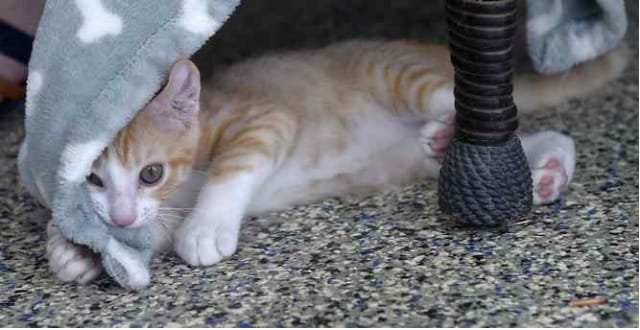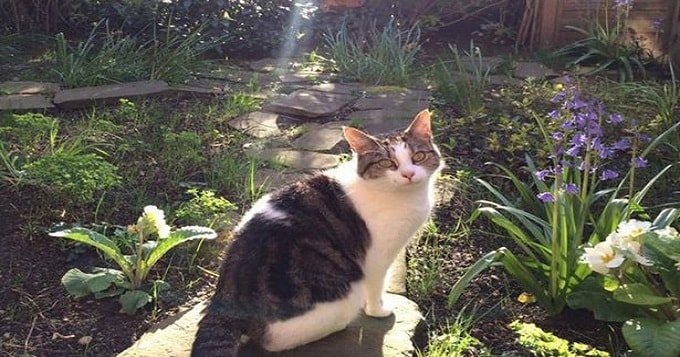TORONTO CANADA - Bronco saunters up the street, eyeing a Toronto Sun photographer-turned-feline paparazzo, who seems to be nappy the day away!
The tubby cat sniffs the fresh air before bolting down the side of an East York house, which is unremarkable except for the presence of a makeshift shelter constructed on the front porch for feral felines like Bronco.
Welcome to Bronco’s only home — a feral cat colony which has been assigned to an agreeable home owner, one of many in Toronto.
Bronco, Myles, Scout, Lily, Gordon, Mayo, and Joey are all ferals who stick close to home.
But the average passerby could easily mistake the group of seven for average everyday house cats. Their fur is immaculately clean. They’re very cautious of outsiders — just like wary house cats that wandered from their owner’s backyard.
And, thanks to some TLC, their bellies are full. With special thanks going to animal lovers like Mary-Chris Staples, who arrives armed with cat food and fresh water.
“They figure cats can take care of themselves,” she said, hauling supplies from a car emblazoned with animal advocacy slogans. “That’s not the case.”
Volunteers like Staples and Lynn Kavanagh make up the true frontline in the effort to care for feral cats relegated to unkind and often deadly streets.
“Even though they’re feral, they’re still domestic animals,” Kavanagh says.
Feral means the cats weren’t socialized when they were kittens. They never got used to human touch.
“But they’re still domestic, so they’re still dependent, they don’t know how to really survive outside,” she said.
“And they will suffer. They won’t necessarily get enough food, they’ll suffer from the cold, they’ll get disease, they’ll get injuries.”
That’s why a total of eight people regularly volunteer to feed Bronco and the rest of his crew.
Come rain, snow, or shine, these cats eat and eat well on a daily basis.
“Someone comes every morning to feed the cats, no matter what,” Kavanagh said.
TRAP-NEUTER-RETURN
No one really knows just how many feral cats call Toronto home.
Depending on who you talk to, it could be anywhere from 100,000 to 200,000.
“That’s kind of the number that people talk about,” Toronto Humane Society CEO Jacques Messier said.
THS is part of the Toronto Feral Cat Coalition, which is working to lower the number of homeless cats on the streets through a policy called Trap-Neuter-Return (TNR).
The idea is to trap feral cats — the females first — and spay or neuter the animals before returning them to the streets.
The policy seems to work and work well. Toronto Animal Services freed a total of 915 feral cats from the burden of a constant reproduction cycle last year alone.
However, TNR can also require volunteers to sometimes trap cats themselves.
“I didn’t know what a trap was. Now I can trap a cat,” volunteer Lynn Kavanagh said.
Ideally, each and every cat would have a home.
A female cat can easily produce a few litters — three to seven kittens each time — in a year.
“I think sometimes there’s a sense that cats are more disposable animals or that they don’t need to be fixed for some reason, or that having kittens is cute,” Kavanagh said, with a sigh.
Colonies begin when abandoned cats are able to reproduce, “then they’re left to fend for themselves,” she said.
As progressive as Toronto’s TNR program may be, Kavanagh wouldn’t mind seeing more resources.
“There are always more supports needed,” she said, watching the cats gingerly approach their daily communal meal.
FERAL DOGS NOT A PROBLEM
How many organizations does it take to pull together feral cats in a city of Toronto’s size?
More than you might think!
The Toronto Feral Cat Coalition consists collectively of Toronto Animal Services, Toronto Humane Society, Toronto Feral Cat Recovery Centre, Ontario SPCA, Animal Alliance of Canada, Toronto Feral Cat Project, Annex Cat Rescue, Urban Cat Relief, and Toronto Cat Rescue.
“Everybody does what they’re good at,” animal services spokesman Mary Lou Leiher said. The city service fixes cats which are trapped by registered colony caretakers.
Don’t see any feral cats in your neighborhood?
Trust the experts though — those cats are indeed there.
“Feral cats are very elusive,” volunteer Lynn Kavanagh says. “They’re around the city. People don’t always know they even exist because, of course, they’re afraid of people.”








